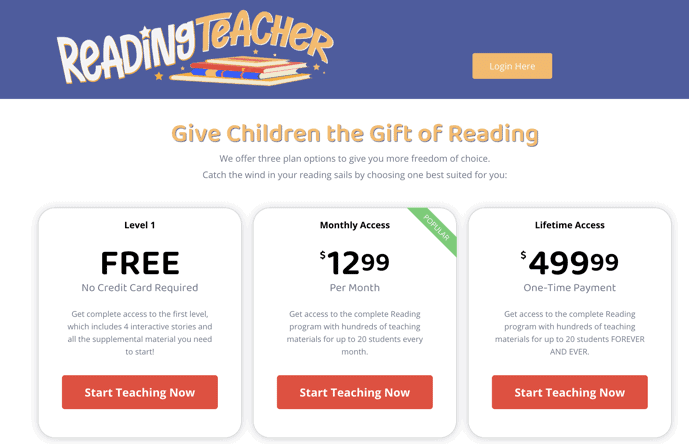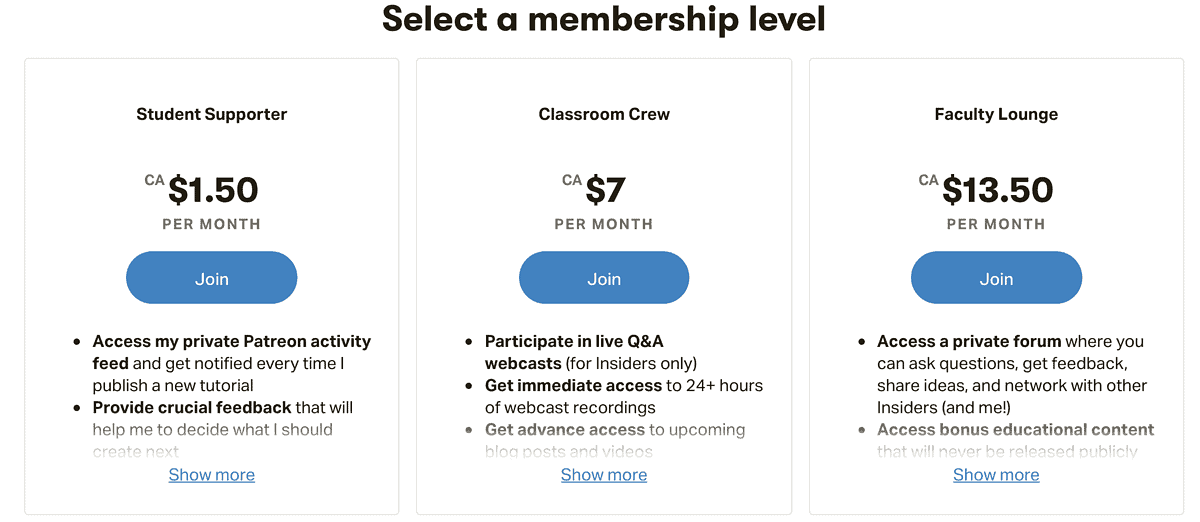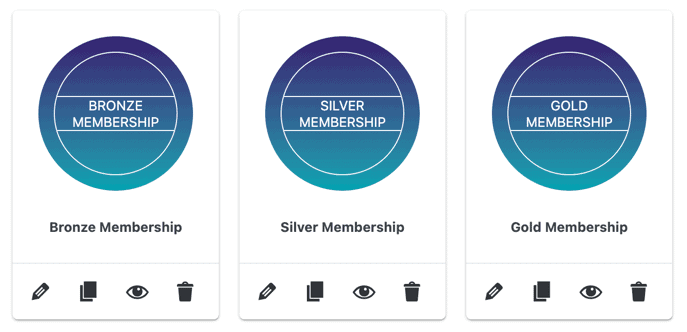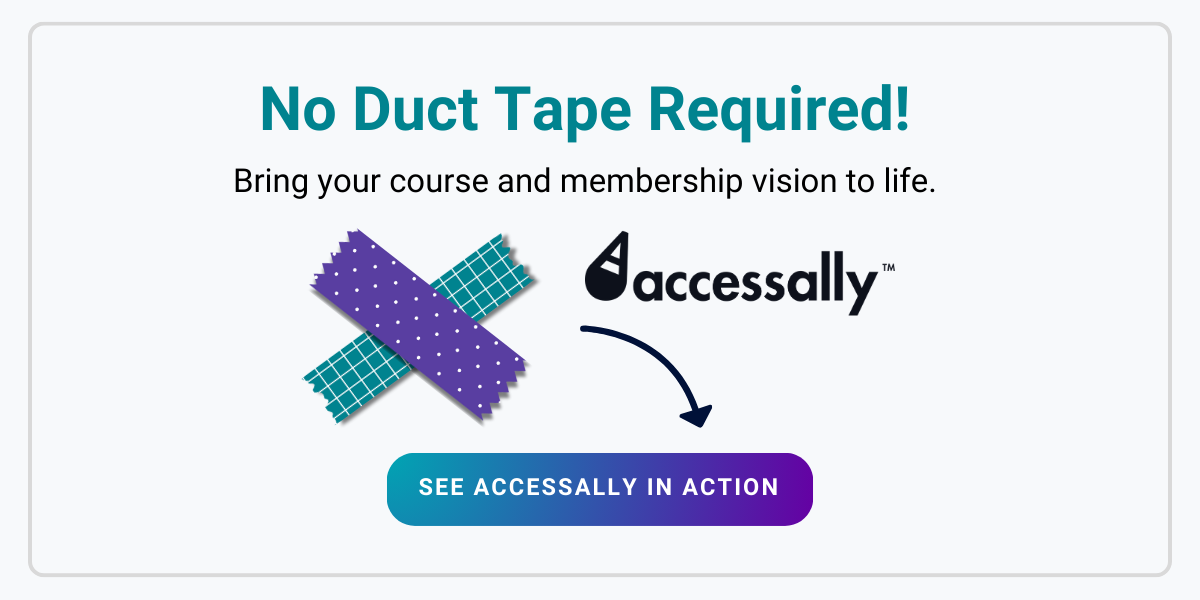You’re planning your membership program, but you’re stumped on naming membership tiers so your offer doesn’t look like everyone else’s.
I get it.
In this article, we are going to share insights about designing membership levels and the best way to come up with creative tier names that will make potential customers hit that “sign up” button fast.
Coming up with creative membership level names
You’ve seen the membership tier cliches, and you don’t want your membership program to fall into that trap.
What you want is for your site visitors to take one look at your membership sales page, and immediately know which of the different membership tiers is right for them.
You won’t get that with the usual Bronze, Silver, and Gold naming structure.
The best way to come up with a creative naming structure for your membership levels is to tie it into the topic of your membership site.
For example, if you have a membership teaching people how to play a musical instrument then some great tiers might be:
- Musician in the Making
- Concert Ready
- Virtuoso
Take a few minutes to jot down membership level names that are specific to your niche. Catchy creative level names are all around when you get brainstorming. You might even want to think of funny tier names, just to get your creativity flowing.
Your new members need to be able to identify which option is right for them based on the level name, but you will also be able to explain the value in your pricing page.
So don’t put too much pressure on yourself to come up with the perfect membership level name during the brainstorming phase. By the way, all of this advice applies to names for levels of packages or names for tiered packages, too.
We’re going to dive deeper into more membership tier naming in a minute. But first, let’s decide how many tiers you need.
How many membership tiers should you offer?
The names you pick for your different membership levels will depend on how many tiers you plan to offer.
The rule of thumb here is to offer no more than 4 membership levels, and preferably just 3.
Why is it better to offer fewer membership levels? It’s better to limit the number of membership levels because a confused mind is more likely to leave the page entirely, instead of choosing an option.
Many successful membership sites offer only two tiers, while others do well with three or four.
Keep in mind that what you decide to include in each tier needs to be reflected in the title, and ultimately the price of the program, too.
Pricing your membership site levels
Pricing a membership site is an art and a science, and you can get more advice on how to do it right in our membership pricing guide. Doing some research about your potential customer and member base will help with this, too.
However, it’s important to consider the price of your different membership levels because the name you choose for each tier needs to be in alignment.
For example, you wouldn’t want to name your membership levels Rose at $50/month, Petunia at $100/month, and Dandelion at $300/month.
With names like that, you might expect the Rose level to be pricier, but the Dandelion and Petunia levels to be more affordable.
Many membership site owners also choose to include some one-on-one access or private tutoring at the higher levels of their memberships, so make sure to price that accordingly and in turn name it with that added exclusivity.
Naming your membership levels based on the benefits and services included is the smart thing to do. For example, your free member level could just be called the free tier on your website, to reduce confusion and entice more members to join.


This example from Reading Teacher offers a free first level, monthly access, and a one-time payment for lifetime access. Here the names for tiered packages are very straightforward.
Membership levels for different types of membership sites
It’s time to look at the different options for naming membership levels, based on the exact type of membership you are offering. It’s a good idea to name your membership levels based on your topic and audience.
Yes, you could pick a brand name for your membership and then have tiers based on the payment duration. Many online membership sites offer monthly and annual subscriptions.
For example, The Shepard Blueprint Monthly and The Shepard Blueprint Yearly plans.
That works fine if you only have two options, but if you really want to encourage people to pick a certain tier then follow the advice below for your particular membership style.
It’s a great idea to offer a price break for customers who upgrade from a monthly subscription to an annual one. Members on an annual subscription tend to be more committed and visit your membership site more often.
Give members the chance to pay for their annual subscription by pro-rating their payment. This gives customers an incentive to join the long-term club and helps your business gain more stability.
1. Skill-based learning memberships
Many membership programs are designed to support people who are starting out and want to improve their skills.
Examples of these types of membership levels include language learning, professional development, crafting, sports, music, writing, coding, gardening, and everything in between.
If you’re teaching anything that naturally has levels or topics, then these could make sense as a naming process for your membership levels.
For example, a martial arts membership program might offer 4 tiers:
- White belt membership
- Green belt membership
- Black belt membership
- Master black belt membership
These are fun names for membership levels, and whether the content is directly tied to the belt level or not, you’re able to convey that the skill level increases with each tier.
Other examples of skill-based memberships include:
- Apprentice
- Maker
- Master
Or:
- Beginner
- Intermediate
- Advanced
- Expert


You can also follow the Treehouse example, and offer one monthly membership price but give people a chance to choose the focus of their learning.
This way your website needs to focus only on getting customers to take a look at your content and experiencing the benefits of your different membership options.
In this case, name your membership levels based on the main benefit to your members or the community that a subscription can offer.
2. Access to different content levels
If you’re selling online memberships that contain different levels of access, then naming your tiers based on the amount of access is a logical plan.
Something as simple as this could work:
- Free
- Paid
- All-Access
Of course, there is always room to jazz up your membership level names. Get creative by borrowing from other markets, like an ice cream shop.
- One spoonful (free plan)
- One scoop (paid plan)
- Banana Split Sunday (all-access)
Or a buffet:
- Membership sampler (free plan)
- A la carte (pay for specific content)
- All you can eat buffet (all-access)
Think about the type of content you’re providing, and what would make it enticing to your prospective members! Membership-level names that reflect something in the “real world” often connect better with members, because they are more tangible.
Your aim needs to be to provide a wide variety of options that cater to different needs and preferences, making it easier for individuals to find the membership level that suits them best.


Example from Data School
3. Different groups of people inside the same members area
If your membership site caters to different types of people, based on their roles, then naming your membership levels based on who they are for is a great way to go.
For example, you might have the following tiers for a school setting:
- Student tier
- Teacher tier
- Parent tier
Or for selling training to corporations, you might look at the following examples:
- Individual
- Team
- Enterprise
You can achieve this type of bulk course enrollment for membership levels with a learning management system (what is an LMS?) like AccessAlly.
These membership tier names are straightforward, and a customer can easily self-identify based on the structure.
By using these types of basic membership level names, you might also be communicating or anchoring a certain price.
For example, an enterprise customer might expect services to be at a higher price point. Whereas an individual member might want a monthly subscription that is more affordable, and easy to cancel.
4. Patrons or different supporter levels
If your membership program is geared toward patrons or supporters of your work, then naming your tiers based on their level of contribution is a great approach.
You want to make people feel special when they sign up to support your work. Remember that all contributions make a difference, even if they are small, so don’t forget to name your lower-level tiers just as sweetly as for your higher-level donors.
Creating an effective membership program goes beyond just offering valuable content and perks. To truly engage your audience and foster long-term loyalty, you need to establish an emotional connection with your members.
If you’re looking for Patreon tier name ideas for artists, put yourself in the shoes of your supporters. Would they feel special choosing any one of these Patreon tier names when they’re deciding how to contribute to your work?
Some examples to get your wheels turning include:
- Supporter of the arts
- Patron of the arts
- Benefactor of the arts
If your brand is focused on hard-hitting independent journalism, or keeping the press free from bias, you might take a look at this structure:
- Journalism Junkie
- Bias Guardian
- Independent Voice Defender
Your membership level naming strategy should match the value you bring, and what people can expect from supporting your work. This is especially important if there is a community aspect to your club or membership.


Example from Dr. Lana Wellness
5. Access to additional support
Another popular membership model strategy is to offer different levels of access to you as the teacher or mentor.
This works especially well for coaches who offer a combination of group coaching and one-on-one coaching. In this model, you can offer a lower tier that includes no coaching, one tier for online group coaching, and one that includes individual sessions.
Sometimes when we’re choosing names for tiers of service, we want to make all of the levels sound equally amazing. Try to resist that urge and focus on the benefits people get at each tier, so that you don’t wind up underselling your top tiers or bottom tiers, which tend to be easier to fulfill.
These might be named something like this (these might not be the most creative tiered package names, but they work):
- Self-serve training
- Group training
- Individual training
Or for more of a coaching slant in a tiered structure:
- Solo practice
- Group coaching
- VIP Coaching
Obviously, you can always dress these membership levels up with your brand’s specific vibe. For example in the health coaching space:
- Wellness Foundations
- Holistic Health Coaching
- Individual Health Assessment and Coaching
Go ahead and start to play with the different words and concepts that apply to your unique membership experience, and see what you come up with.
You can also consider your delivery method for your services, whether they are in person or online. Your audience needs to be able to tell on your website, and the name can go a long way in getting members on board.
Sometimes some of the best membership level names are pretty basic. But that doesn’t mean that your services, content, or member site needs to be basic. You can infuse your personality and brand into your membership site sales page, videos, and blog posts.
Moving between membership levels
One thing that can also make or break your membership tier naming convention is how easy it is to move between tiers.
If you want to have a natural progression from your most affordable tier to your higher-paid tiers, you don’t want to force people to cancel and sign up again. Or worse, have to email you to move them to a new plan manually.


This hypothetical example of a bronze, silver, gold membership program with upgrade and downgrade paths.
Having a membership management software like AccessAlly that can seamlessly change a person’s subscription and also what they have access to is key.
Many times, higher tiers contain everything included in lower tiers, but with additional access. Find out what membership tools allow you to create the type of membership levels you have in mind, without creating a headache for you or your members.
You will also likely want to be able to pro-rate any past payments toward an upgrade or a downgrade in membership plans, so keep that in mind.
Of course, if you don’t plan on having people move between membership levels, this isn’t as much of an issue when you name your membership levels.
Name your membership levels in line with your brand
You probably have a lot of ideas by this point. Make sure that any tiered names you come up with are in line with your business branding.
How can you confirm that?
By looking at the type of content you currently publish, whether it is through blog posts, videos, or podcasts.
Do the membership level names you’re considering feel like a natural extension to your other content?
Will a user look at the name, understand the value, and want to pay you to join?
If not, then your business branding is not clear enough.
Another great litmus test is to see if a customer or friend can explain why it’s worth signing up for your memberships in a few words or less.
It’s time to start naming membership levels
I hope this article gave you some inspiration and a few fresh membership level names to inspire your subscription programs. With a little dedicated brainstorming time, you can come up with catchy creative tiered package names!
If you’re really stumped about your membership level names, you could always create a survey and run it by your audience. Sometimes a quick post or contest to get potential members involved in your business can make people feel like they are a part of something bigger.
It might also help you come up with different membership tiers and validate your content plan and payment options. Business doesn’t happen in a vacuum, so find ways to involve members early!
Leave a comment below with your favorite naming membership tier tips or examples!






